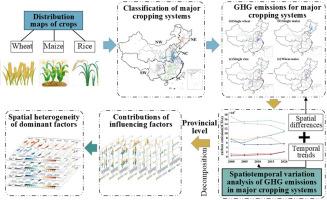种植制度对温室气体排放有实质性影响吗?基于中国实证研究的动态与关键因素分析
IF 5.7
1区 农林科学
Q1 AGRONOMY
引用次数: 0
摘要
不同的种植制度在温室气体(GHG)排放方面表现出显著差异。了解这些系统的温室气体排放绩效,有利于科学地分配减排责任。然而,对整个地区主要种植系统温室气体排放的时空动态和根本原因的全面调查仍然有限。在对中国7种种植制度进行分类的基础上,计算了中国7种种植制度2000 - 2020年的温室气体排放量。采用对数平均分异指数(LMDI)方法对各省不同种植制度温室气体排放变化的驱动因素进行了分解。结果表明,双稻和单稻是主粮生产中温室气体排放的最大贡献者,占总排放量的一半以上。值得注意的是,双季稻的温室气体排放量显著下降,特别是在华南地区,降幅超过30%。农业经济、种植结构、单位农业GDP用地面积和农业劳动力结构是影响复种制温室气体排放波动的主要因素,且具有明显的时空异质性。本研究确定了不同种植制度之间温室气体排放的空间差异及其影响因素,强调了制定区域特定管理策略的必要性。研究结果为制定有针对性的区域粮食生产温室气体排放控制策略提供了有价值的决策支持。本文章由计算机程序翻译,如有差异,请以英文原文为准。

Does the cropping system have a substantial influence on greenhouse gas emissions? Dynamics and key factors-based insights from an empirical study of China
Different cropping systems exhibit significant variations in greenhouse gas (GHG) emissions. Understanding the GHG emission performance of these systems is conducive to the scientific allocation of emission reduction responsibilities. However, comprehensive investigations into the spatiotemporal dynamics and underlying causes of GHG emissions in major cropping systems across entire regions remain limited. Based on the classification of seven cropping systems in China, this study calculates their GHG emissions from 2000 to 2020. The Logarithmic Mean Divisia Index (LMDI) method is employed to decompose the factors driving changes in GHG emissions from various cropping systems at the provincial level. The results indicate that double rice and single rice were the largest contributors to GHG emissions in staple food production, accounting for over half of the total emissions. Notably, GHG emissions from double rice have decreased significantly, particularly in South China, where reductions exceeded 30 %. The agricultural economy, planting structure, land area per unit of agricultural GDP (AGDP), and agricultural labor structure are the dominant factors influencing fluctuations in GHG emissions from multiple cropping systems, exhibiting distinct spatiotemporal heterogeneity. This study identifies spatial differences in GHG emissions and their influencing factors among different cropping systems, highlighting the need for region-specific management strategies. The findings provide valuable decision-making support for formulating targeted GHG emission control strategies in regional food production.
求助全文
通过发布文献求助,成功后即可免费获取论文全文。
去求助
来源期刊
CiteScore
10.30
自引率
9.70%
发文量
415
审稿时长
69 days
期刊介绍:
Agricultural and Forest Meteorology is an international journal for the publication of original articles and reviews on the inter-relationship between meteorology, agriculture, forestry, and natural ecosystems. Emphasis is on basic and applied scientific research relevant to practical problems in the field of plant and soil sciences, ecology and biogeochemistry as affected by weather as well as climate variability and change. Theoretical models should be tested against experimental data. Articles must appeal to an international audience. Special issues devoted to single topics are also published.
Typical topics include canopy micrometeorology (e.g. canopy radiation transfer, turbulence near the ground, evapotranspiration, energy balance, fluxes of trace gases), micrometeorological instrumentation (e.g., sensors for trace gases, flux measurement instruments, radiation measurement techniques), aerobiology (e.g. the dispersion of pollen, spores, insects and pesticides), biometeorology (e.g. the effect of weather and climate on plant distribution, crop yield, water-use efficiency, and plant phenology), forest-fire/weather interactions, and feedbacks from vegetation to weather and the climate system.

 求助内容:
求助内容: 应助结果提醒方式:
应助结果提醒方式:


